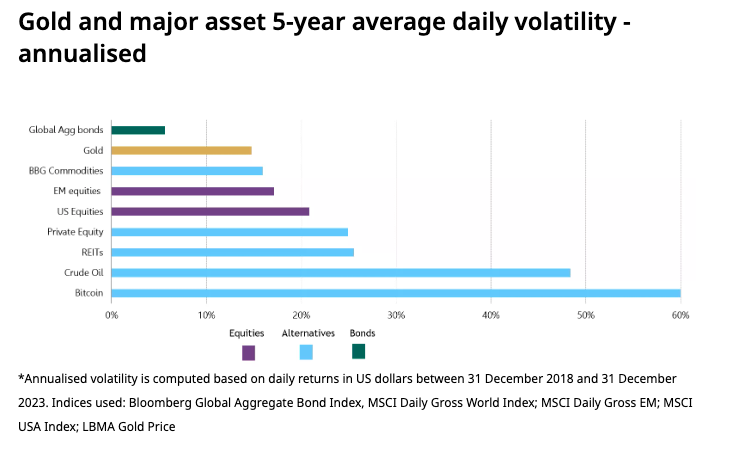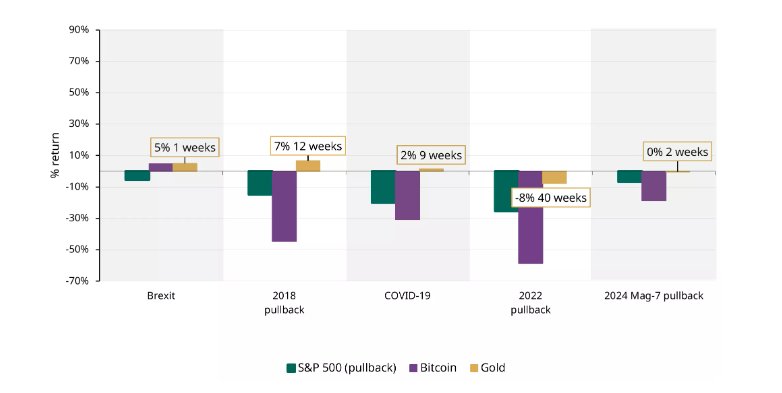Many investors put gold and Bitcoin in the same category. Some people even call Bitcoin "digital gold."
Is this a fair comparison?
There are certainly similarities between the two assets, but there are some significant differences as well.
Gold and Bitcoin have both provided solid returns this year. Gold prices have risen by over 22 percent, reflecting the weakening U.S. dollar and growing investor interest. Bitcoin has charted even bigger returns, up over 150 percent since January.
There are other more fundamental similarities. Both gold and Bitcoin can be used as a transactional currency as well as a store of value. Neither are controlled by governments and central banks. This being the case, both gold and Bitcoin come with significantly less counterparty risk than many other asset classes. Both assets also have a naturally limited supply.
But there are also significant differences between gold and Bitcoin.
First, gold is much less volatile than Bitcoin. As the World Gold Council put it, "Gold and Bitcoin sit at the opposite ends of the volatility spectrum."
In terms of volatility, Bitcoin behaves more like a tech stock. That's because according to major asset managers, Bitcoin's strongest use case is as an indicator of overall blockchain adoption.
Another difference between Bitcoin and gold is their correlation with other assets in a diversified portfolio. According to the World Gold Council, "The numbers demonstrate that Bitcoin and gold have different drivers and in times of increased stress in market conditions, gold provides a unique impact on a diversified portfolio."
Comparing gold's performance with Bitcoin during periods of significant economic turmoil demonstrates gold's role as a safe haven distinct from Bitcoin.
As the World Gold Council summed it up, "What you can find is that once established, Bitcoin has not demonstrated the same characteristics as gold at those critical moments. When you expect protection against significant market moves, Bitcoin tracked risk assets."
World Gold Council analysis found that adding gold to a portfolio "provides demonstrated diversification." On the other hand, adding Bitcoin to a portfolio is more similar to increasing exposure to high-risk equities such as tech stocks.
"Allocating gold to the portfolio provides an increasing level of risk-adjusted return at any level of allocation. Holding it for the past decade (rebalancing as required) would have increased the risk-adjusted returns and lowered volatility.
"Allocating Bitcoin to a portfolio and holding it for the past decade (rebalancing) would have increased the risk-adjusted return at a certain level, in this case, 2.5 percent. However, beyond that allocation level, the portfolio volatility would have been higher; drawdowns greater; the risk-adjusted return would deteriorate."
So, while gold and Bitcoin are similar in some ways, they are not the same investment. Each has unique characteristics and risks.
The World Gold Council summed it up this way:
"While Bitcoin may bring certain benefits to a diversified portfolio, the data shows that it is not an equivalent investment to gold or substitute for gold as it adds risk through increased volatility and returns comparable to high-risk equity assets."
Money Metals Exchange and its staff do not act as personal investment advisors for any specific individual. Nor do we advocate the purchase or sale of any regulated security listed on any exchange for any specific individual. Readers and customers should be aware that, although our track record is excellent, investment markets have inherent risks and there can be no guarantee of future profits. Likewise, our past performance does not assure the same future. You are responsible for your investment decisions, and they should be made in consultation with your own advisors. By purchasing through Money Metals, you understand our company not responsible for any losses caused by your investment decisions, nor do we have any claim to any market gains you may enjoy. This Website is provided “as is,” and Money Metals disclaims all warranties (express or implied) and any and all responsibility or liability for the accuracy, legality, reliability, or availability of any content on the Website.
Recommended Content
Editors’ Picks

AUD/USD: Extra gains look likely in the near term
AUD/USD added to Wednesday’s gains and broke above the key 0.6200 barrier following the pronounced retracement in the US Dollar amid widespread concerns over the impact of Trump’s tariffs on the global trade.

EUR/USD: There is a minor resistance at 1.1300
EUR/USD gathered renewed steam and advanced north of 1.1200 the figure to clinch new highs, always on the back of intense tariff woes and the marked sell-off in the Greenback.

Gold flirts with record peaks near $3,175, Dollar tumbles
Gold continued its record-setting rally on fresh tariff-related headlines, surging past the $3,170 mark per troy ounce after the White House confirmed new tariffs, sparking another round of US Dollar selling.

Bitcoin miners scurry to import mining equipment following Trump's China tariffs
Bitcoin (BTC) miners are reportedly scrambling to import mining equipment into the United States (US) following rising tariff tensions in the US-China trade war, according to a Blockspace report on Wednesday.

Trump’s tariff pause sparks rally – What comes next?
Markets staged a dramatic reversal Wednesday, led by a 12% surge in the Nasdaq and strong gains across major indices, following President Trump’s unexpected decision to pause tariff escalation for non-retaliating trade partners.

The Best brokers to trade EUR/USD
SPONSORED Discover the top brokers for trading EUR/USD in 2025. Our list features brokers with competitive spreads, fast execution, and powerful platforms. Whether you're a beginner or an expert, find the right partner to navigate the dynamic Forex market.

